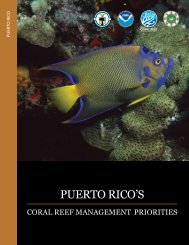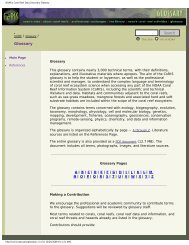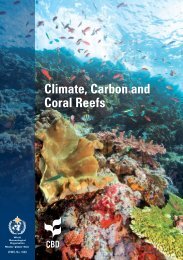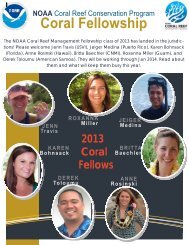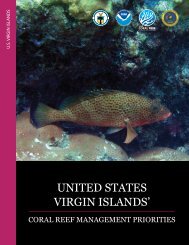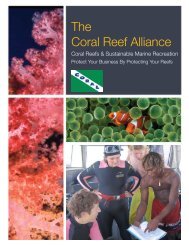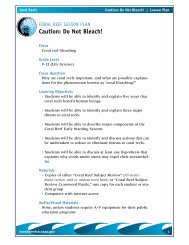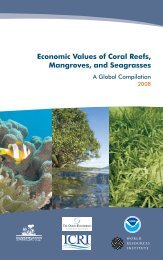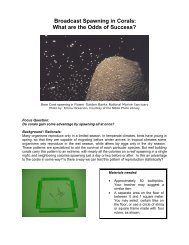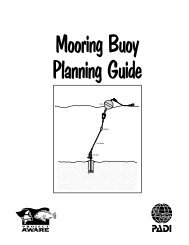Handling procedures adopted by the Mountains-in-the-<strong>Sea</strong> Research Groupby Les WatlingFig. 18a and 18b. The Mountains-in-the-<strong>Sea</strong> ResearchGroup in actionThe Mountains-in-the-<strong>Sea</strong> Research groupgot its start in the canyons ofthe northeastern United States, where we were first confronted with octocorals of various kinds, butmost of which were pretty hardy. During the course of our subsequent expeditions to the New Englandseamounts of the North Atlantic, we have come to recognize that certain of the octocoral families haveto be handled differently from others. Handling issues are especially important when bringing specimensfrom the cold deep sea through warm temperate or tropical surface waters. <strong>Deep</strong>water temperaturescan drop to 2 ºC. However, the collection and handling procedures outlined below can be modifiedsomewhat when dealing with surface waters that are approximately the same as those at the collectiondepth. We do not yet know much about the temperature tolerance of octocorals and antipathariansliving below normal scuba diving depth, so our guiding principle has been use methods that cause as littleshock to the organism’s tissues as possible.<strong>Collection</strong> ProceduresManipulator arm. We found that if octocorals and black corals (and perhaps other delicate specimensas well) are the only items to be collected with the manipulator arm of the submersible or ROV, thestandard three-fingered claw should be replaced by a cutting and gripping style claw. The one designedfor us by the Institute for Exploration can be seen on NOAA’s Ocean Explorer web site. It consists oftwo stainless steel angle-iron pieces with two Nalgene tubing pieces arranged so that as the sharpenededges of the opposing angle-irons cut the coral stem the tubing acted to grip the cut piece.<strong>Collection</strong> boxes. When there is a possibility that the specimens will be recovered through surfacewaters that are more than a few degrees warmer than the temperatures experienced at the collectionsite, we try to use tightly sealing insulated bio-boxes. In some cases we have not been able to have allinsulated boxes, so we have experimented with which corals put in the non-insulated boxes19
and still be useable when recovered. Bamboo corals are the least likely to be useful for anymorphological or genetic work if they spend much time at temperatures much above those where theywere collected. Note here also that recovery times for the submersible or ROV can be quite long. Forexample, after Alvin enters the warm surface waters, another 45 minutes can pass before the sub isrecovered and safely secured and you have access to the specimen boxes. With ROVs, this time can beshortened somewhat, but can still seem excruciatingly long.Oxygenation. Some ROV dives are as long as 17 hours or more. In that case the lid of the bio-boxshould be opened every 2 hours or so in order to oxygenate the water in the box. Remember that somedeep-sea waters are low in oxygen as it is, so specimen deterioration can occur in the box. In a fewcases we have seen that associates of the corals will abandon the host when conditions get bad in thebox, but for the most part the associates hang on to the end.Mucus production. Many octocorals secrete copious amounts of mucus when stressed. As a result wetry to be careful about what families of octocorals and black corals go in a bio-box together. Forexample, antipatharians go into a box of their own whenever possible. Bamboo corals, large primnoids(such as Primnoa resedaeformis), and the very large Paragorgia spp. are pretty good mucusproducers. Small primnoids, chrysogorgiids, plexaurids, and other small octocoral species do finetogether in one box.Video data collection. Before collection we take very close video of the specimen (using lasers forscale), especially of the colony base which is often not recovered. Longer term close-up video also canbe used to show the tentacle pinnules (which can often be counted if the light is right), and to see howany associates living on the coral might be behaving. In practice, we have not been able to get more than15 minutes of close-up video, however, most likely because the photons from the lights begin to heat thepolyps and they start to close or show other signs of being stressed. Video of the surrounding habitat,including small-scale geological features, surficial substrate type, macro-associates and other sedentaryfauna should also be recorded, as described in the following sectionRecord keeping. Every place where the ROV or submersible stops is given a station number and thespecimen(s) collected are assigned individual specimen numbers. For example, in our system, KEL408-1, is interpreted to mean Kelvin seamount, 4 th dive, 8 th station, 1 st specimen. With this system wecan determine exactly which video we need to view to see the collection of the specimen. We also notethe bio-box into which the specimen was put and make a “map” of each bio-box with tentativespecimen names, small drawings of the specimen showing its shape, and the order in which thespecimens were put into the box. These details will be very important in sorting out the 15-20specimens in the boxes when everything gets to the surface.Shipboard Procedures and Other ConsiderationsImmediate storage. While the ROV or submersible is in the water, a sufficient number of 5-gallonbuckets of seawater are chilled to the at-depth temperature. Each bucket is labeled for a singlespecimen. As soon as the specimens can be removed from the bio-boxes, they are put into the bucketsand taken for storage in the cold room.20





